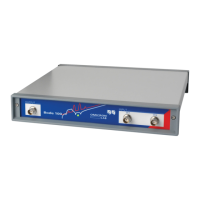77
Calibrating the Bode 100
Hint: Use the User Calibration for the highest accuracy of measurement
results or if you want to compensate for highly frequency selective components
in your measurement setup such as narrow-band measurement probes.
7.1.3 Hierarchy of Calibration Methods
The following table gives an overview of the Bode 100 calibration methods.
Table 7-1:
Calibration methods
You can activate the User Calibration and the Probe Calibration at the same
time as shown below.
Figure 7-1:
Activating
User Calibration and
Probe Calibration
If both the User Calibration and the Probe Calibration are activated, the more
accurate User Calibration is used. If measurement parameters are changed
and the User Calibration becomes void the Bode 100 switches automatically to
the Probe Calibration; the User Calibration remains switched off until the
Bode 100 is recalibrated.
7.2 Calibration in the Gain/Phase Mode
(Internal Reference Connection)
For calibrating the Bode 100 in the Gain/Phase mode you find a practical
example in 3.3 "Example: Gain/Phase Measurement" on page 24.
Note: The Probe Calibration is performed in the same way as the
User Calibration.
Measurement Mode User Calibration Probe Calibration
Gain/Phase Calibrates at only one
frequency
(measurement frequency)
Calibrates the complete
frequency range.
Calibration factor for the
measurement frequency
is calculated by linear
interpolation.
Impedance/Reflection
Frequency Sweep Calibrates at the exact
frequency points used for
the sweep
Calibrates the complete
frequency range.
Calibration factors for the
measurement frequencies
are calculated by linear
interpolation.
Frequency Sweep
(External Coupler)

